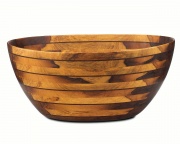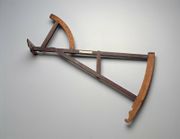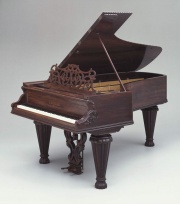Difference between revisions of "Rosewood"
| Line 1: | Line 1: | ||
[[File:1984.66-SC58785.jpg|thumb|]] | [[File:1984.66-SC58785.jpg|thumb|]] | ||
| + | [[File:Backstaff MFA.jpg|thumb|Backstaff <br>MFA# 1993.533]] | ||
== Description == | == Description == | ||
Any of several wood from trees of the genus ''Dalbergia''. Rosewood timber has a reddish-purple color and produces a rose-like smell when cut. The wood has a fine grain, smooth texture, and polishes to a high gloss. Rosewood is used for cabinets, musical instruments, piano cases and veneer. It was popular during the late 18th and early 19th centuries. | Any of several wood from trees of the genus ''Dalbergia''. Rosewood timber has a reddish-purple color and produces a rose-like smell when cut. The wood has a fine grain, smooth texture, and polishes to a high gloss. Rosewood is used for cabinets, musical instruments, piano cases and veneer. It was popular during the late 18th and early 19th centuries. | ||
| − | + | * Brazilian rosewood (''Dalbergia nigra'') tends to have a more variegated reddish color. A water extract of Brazilian rosewood with not fluoresce while that of most other rosewoods fluoresces a pale blue/green color. | |
| − | + | * East Indian rosewood or Bombay blackwood (''Dalbergia latifolia'') tends to be a darker purple or brown with a tightly packed pore density. | |
| − | + | * Honduras rosewood (''Dalbergia stevensonii'') has an uneven pore size | |
== Synonyms and Related Terms == | == Synonyms and Related Terms == | ||
| Line 16: | Line 17: | ||
[[File:1986.56-SC14561.jpg|thumb|]] | [[File:1986.56-SC14561.jpg|thumb|]] | ||
| − | == | + | == Physical and Chemical Properties == |
| − | Tree height = to 30m | + | * Tree height = to 30m |
| + | * Density = 50-63 ppcf | ||
| − | + | == Risks == | |
| − | |||
| − | |||
| − | |||
| − | |||
| − | |||
| − | |||
Contact may cause allergic rashes. Inhalation of dust may cause asthma | Contact may cause allergic rashes. Inhalation of dust may cause asthma | ||
| Line 40: | Line 36: | ||
</gallery> | </gallery> | ||
| − | + | == Resources and Citations == | |
| − | == | ||
* G.S.Brady, ''Materials Handbook'', McGraw-Hill Book Co., New York, 1971 Comment: p. 670 | * G.S.Brady, ''Materials Handbook'', McGraw-Hill Book Co., New York, 1971 Comment: p. 670 | ||
| Line 49: | Line 44: | ||
* F. H. Titmuss, ''Commercial Timbers of the World'', The Technical Press Ltd., London, 1965 | * F. H. Titmuss, ''Commercial Timbers of the World'', The Technical Press Ltd., London, 1965 | ||
| − | * Wikipedia | + | * Wikipedia: http://en.wikipedia.org/wiki/Rosewood (Accessed Oct. 3, 2005) |
* Michael McCann, ''Artist Beware'', Watson-Guptill Publications, New York City, 1979 | * Michael McCann, ''Artist Beware'', Watson-Guptill Publications, New York City, 1979 | ||
| Line 59: | Line 54: | ||
* ''The American Heritage Dictionary'' or ''Encarta'', via Microsoft Bookshelf 98, Microsoft Corp., 1998 | * ''The American Heritage Dictionary'' or ''Encarta'', via Microsoft Bookshelf 98, Microsoft Corp., 1998 | ||
| − | * | + | * WMuseum of Japanese Traditional Art Crafts at http://www.nihon-kogeikai.com/ (Jap. term) |
[[Category:Materials database]] | [[Category:Materials database]] | ||
Revision as of 14:34, 3 October 2020
Description
Any of several wood from trees of the genus Dalbergia. Rosewood timber has a reddish-purple color and produces a rose-like smell when cut. The wood has a fine grain, smooth texture, and polishes to a high gloss. Rosewood is used for cabinets, musical instruments, piano cases and veneer. It was popular during the late 18th and early 19th centuries.
- Brazilian rosewood (Dalbergia nigra) tends to have a more variegated reddish color. A water extract of Brazilian rosewood with not fluoresce while that of most other rosewoods fluoresces a pale blue/green color.
- East Indian rosewood or Bombay blackwood (Dalbergia latifolia) tends to be a darker purple or brown with a tightly packed pore density.
- Honduras rosewood (Dalbergia stevensonii) has an uneven pore size
Synonyms and Related Terms
jacaranda; East Indian rosewood (Bombay blackwood, Dalbergia latifolia); Honduras rosewood (Dalbergia stevensonii); Brazilian rosewood (palisander, Rio rosewood, Bahia rosewood, Dalbergia nigra); Rosenholz (Deut.); bois de rose (Fr.); palissander (Ned.); shitan (Jap.); palisandro (Esp.); palissandro (It.)
Physical and Chemical Properties
- Tree height = to 30m
- Density = 50-63 ppcf
Risks
Contact may cause allergic rashes. Inhalation of dust may cause asthma
Additional Images
Resources and Citations
- G.S.Brady, Materials Handbook, McGraw-Hill Book Co., New York, 1971 Comment: p. 670
- Ralph Mayer, A Dictionary of Art Terms and Techniques, Harper and Row Publishers, New York, 1969 (also 1945 printing)
- F. H. Titmuss, Commercial Timbers of the World, The Technical Press Ltd., London, 1965
- Wikipedia: http://en.wikipedia.org/wiki/Rosewood (Accessed Oct. 3, 2005)
- Michael McCann, Artist Beware, Watson-Guptill Publications, New York City, 1979
- George Savage, Art and Antique Restorer's Handbook, Rockliff Publishing Corp, London, 1954
- Random House, Webster's Encyclopedic Unabridged Dictionary of the English Language, Grammercy Book, New York, 1997
- The American Heritage Dictionary or Encarta, via Microsoft Bookshelf 98, Microsoft Corp., 1998
- WMuseum of Japanese Traditional Art Crafts at http://www.nihon-kogeikai.com/ (Jap. term)







